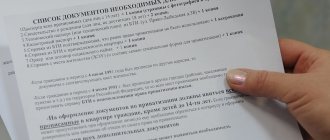Privatization of housing: how did it happen?
Mass privatization of housing was officially announced (authorized) in Russia on July 4, 1991. On this day, the Supreme Council of the RSFSR adopted the “Law on the privatization of housing stock in the RSFSR.” And a day earlier, the Supreme Council of the RSFSR approved the “Law on the privatization of state and municipal enterprises in the RSFSR.” Two privatizations - good and bad - began almost simultaneously.
It cannot be said that this was unexpected news for Soviet citizens. They guessed that the privatization of housing was inevitable and were even sure that they would definitely have to pay for their own housing. As a result, they were mainly concerned only with the amount of money that the state would set as the price for specific square meters. And also - the established deadline and method of payment.
The legislator answered the questions that concern citizens only in the most general terms. According to the law, citizens living in houses of state and municipal funds received the right to free privatization of at least 18 square meters. m of total area of used housing per resident. And additionally at least 9 free sq. m – per one family. The difference between the cost of the apartment and the cost of “free housing” was payable.
History has decreed that at the dawn of housing privatization, the Russian state was never able to inform its citizens how much their apartments were fairly worth. But very soon citizens personally learned how free market prices really work and what hyperinflation is. As a result, they were no longer interested in government calculations; everyday mathematics turned out to be more important.
However, the assessment commissions created under local councils to calculate the cost of privatized housing continued to work, despite the absolute meaninglessness of the instructions given to them. Until, at the end of December 1992, the Supreme Council of the Russian Federation made the only decision possible at that time - to guarantee Russian citizens the right to free privatization of housing.
Another life of Vitaly Naishul
The word “privatization,” like many other words from the vocabulary of reformers, was borrowed from the West. True, in English it sounded slightly different - “reprivatization”: this term denoted the methods of economic policy known as “Reaganomics” and “Thatcherism”. These methods typically included: denationalization, deregulation, and public-private partnerships.
The first Soviet economist to use the word “privatization” in the context of analyzing the crisis of the domestic economy was Vitaly Naishul, an employee of the Economic Institute of the USSR State Planning Committee. In the mid-80s of the last century, his manuscript “Another Life,” distributed through samizdat channels, was well known among Soviet economic theorists who read not only the right books.
The first chapter of the manuscript was called “Reform,” which reflected its content: it described in detail the future economic reform in the USSR. Today we can say that it was just another utopia in the spirit of “people's capitalism”, which was very popular at that time, but it was its author who came up with the “voucher”. And he specifically described the reform that we know today as “housing privatization.”
Another life as imagined by Vitaly Naishul: “In parallel with the economic reform, the country will undergo a housing reform, which will affect many of us. All citizens of the country will receive a living space in which they are permanently registered as full property.” This was written in 1985, even before “perestroika”.
But I decided to recall this book by Vitaly Naishul not only to clarify who actually is the “author” of the idea of privatization in Russia. There is another reason directly related to our topic. In 1994, Vitaly Naishul made a conclusion that may seem absurd: the privatization of housing did not happen in the country yesterday, but much earlier - at the turn of the 60s and 70s.
To understand this conclusion, it is not enough to look at historical facts. We should also give up the very persistent socialist myth that socialism and such phenomena as private property and the market are practically incompatible. This incompatibility is undeniable only in theory, but in practice socialism is always only an attempt - and always unsuccessful - to eliminate private property and the market.
State and property
To begin with, let us remember that in the USSR there were so-called cooperative apartments. Or - what is more precise - apartments in a cooperative, since their legal owner was the cooperative, and the residents were only shareholders. This situation changed in March 1988 with the adoption of a joint resolution of the CPSU Central Committee and the USSR Council of Ministers “On measures to accelerate the development of housing cooperation.”
This document established that a member of the cooperative, if he has fully paid the share contribution, in case of leaving the cooperative, has the right to receive the already paid share contribution back minus depreciation or transfer the apartment to his relatives or other persons. All that was required was the consent of the cooperative. In this case, there was actually a purchase and sale carried out in two stages. First, the cooperative bought the apartment from the shareholder, then sold it to the residents.
But this rule did not last long: on July 1, 1990, the law “On Property in the USSR” came into force, according to which a member of the cooperative who paid the share contribution in full was recognized as the owner of the already paid property. Cooperative apartments turned into private ones. In addition, the new law established for the first time that the tenant of residential premises in state and public housing stock and members of his family have the right to purchase the corresponding apartment or house from the owner. The only thing that was not specified was how to do it.
The new type of property was called “citizen property.” The usual concept of “personal property” was no longer used, but the union government did not dare to openly use the forbidden phrase “private property”. However, from the text of the law it followed: the property of citizens is real, freely alienable private property.
Housing privatization: what was it?
Give the apartment to the state
Privatization non-stop
But this law did not last long. On January 1, its effect was canceled on the territory of Russia by a decision of the Supreme Council of the RSFSR. The RSFSR Law “On Property in the RSFSR” came into force. With regard to the recognition of citizens' property rights to housing, nothing has changed formally; Russian law literally repeated the provisions of the all-Union law. The only novelty was that for the first time apartments were “registered” in the law as citizens’ property.
Property and freedom
Our short historical excursion allows us to draw two conclusions. Conclusion one: it is impossible to “create” private ownership of housing by changing the current law. It is required that higher authorities order lower authorities: to give citizens what is due to them. In other words, it is necessary to remove all existing prohibitions on the free use of private property.
Conclusion two: the timid attempt of the Soviet government to “monetize” the housing rights of citizens was doomed to failure. In this regard, the history of the implementation of the Resolution of the Council of Ministers of the USSR of December 2, 1988 No. 1440 “On the sale of apartments in state and public foundation buildings to citizens as personal property” is very indicative. Historically, this was the first attempt at housing privatization.
This document did not declare, but rather allowed local authorities to sell apartments to their tenants. In addition, the sale of unoccupied apartments in buildings subject to reconstruction or major repairs was allowed. Let us emphasize: this resolution was drawn up precisely as an instruction. It, in particular, contained a recommendation to sell all apartments in a particular building.
An insignificant part of the country's population actually took advantage of the opportunity to buy their own housing from the state. There is evidence that before the start of mass free privatization of housing in the Russian Federation, only 0.2% of the housing stock was sold. But in order to understand why Soviet citizens valued so little the opportunity to own housing, one must answer a very insidious question: what did state ownership of city apartments mean in Soviet times?
In the language of Soviet housing law, the answer should be as follows: the state acted as a landlord in relations with residents and, in this capacity, was the owner of all apartments. But then another question arises: did the authorities have the opportunity to evict residents from the apartment where they were permanently registered?
In Stalin's times this was certainly possible. But in times of “stagnation,” the state had virtually no legal grounds left to evict an ordinary law-abiding tenant from his apartment. Vitaly Naishul pointed out this circumstance when he concluded that the privatization of housing occurred during a period of “stagnation.” Living space has become a territory of personal freedom for a citizen.
According to a tacit agreement, the state no longer invaded this territory and, even more, took upon itself the obligation to protect it from the claims of third parties. Vitaly Naishul called this phenomenon “Soviet customary law” and it really resembles many feudal customs. Sharikov’s dream came true: all citizens received the irrevocable right to guaranteed square meters.
This makes it clear why Soviet citizens did not see the point in buying their own housing from the state. The first reason is that it was an illegitimate transaction. You cannot first give something and then demand money for it. The second reason is that there was no what today is called the “market value” of real estate. For citizens, it was not the privatization of housing as such that made sense, but its real “monetization.” But this required a free market.
Read further: “Housing privatization: how to become a millionaire?”
Text: Vyacheslav Kostrov
What is the voucher worth now?
Chubais promised two Volgas for each voucher. And some Russians actually received approximately this amount - if they invested their checks wisely. Properly - to enterprises that did not go bankrupt in the difficult 90s and still exist. Rosneft shares
, which could be purchased with a voucher, now cost approximately 700 thousand rubles,
Gazprom
cost approximately a million rubles. But it is worth understanding that many owners have already sold these securities earlier (which in the case of Rosneft is not so bad).
Since then, some other enterprises have survived, but the shares purchased in the 90s can now earn only a small amount of money. Many enterprises have managed to go bankrupt - and shareholders receive payments last in line (and the turn simply does not reach them - the company’s property is running out).
Or maybe it would have been more profitable not to use the voucher then in order to sell it now?
? It was possible to exchange a privatization check for shares until June 30, 1994, that is, in 2021 it will no longer be possible to participate in privatization. But it can be sold.
The price of the paper itself depends on whether the check was cleared or not. “Uncanceled” vouchers cost a little more, but canceled ones have holes punched in them, some marks on them, or a part has been cut off.
Vouchers cost differently:
- in “worn” condition – from 250 rubles;
- in perfect condition – 1-2 thousand rubles;
- vouchers of rare series - cost several times more than usual ones in perfect condition;
- an unissued voucher (form with a control coupon) costs up to 10 thousand rubles.
That is, everything depends on the safety of the document, its series and number. Unredeemed vouchers of series “01”, papers with interesting combinations of numbers in the number and series, first numbers of series, etc. are well valued.
In addition, you can sell shares of enterprises purchased with vouchers that have already gone bankrupt. In this case, the condition of the enterprise does not play any role - the paper itself and its rarity are valued. For example, a share of Hermes OJSC with a par value of 10 thousand rubles
The 1994 issue is not so expensive - about 140 rubles, but 11 million such shares were issued. For rarer shares, prices will be higher.
It is also important to beware of counterfeits
– there is a real hunt for vouchers with rare numbers, and forging a document from the 90s is not so difficult with modern technologies.
Which apartments can be privatized
You can re-register as your property:
- state-owned apartments;
- apartments owned by district or village administrations.
Only those Russians who permanently live in it on social rental terms and have not previously privatized their housing can obtain ownership of a state or municipal apartment. At the same time, an adult can refuse privatization, but a child cannot; his share is obligatory.
Apartments located in dilapidated buildings, in closed military camps, as well as service apartments, cannot be privatized. It is also prohibited to transfer ownership of housing to citizens living on the basis of a free use agreement.
Read who is eligible for social housing.









